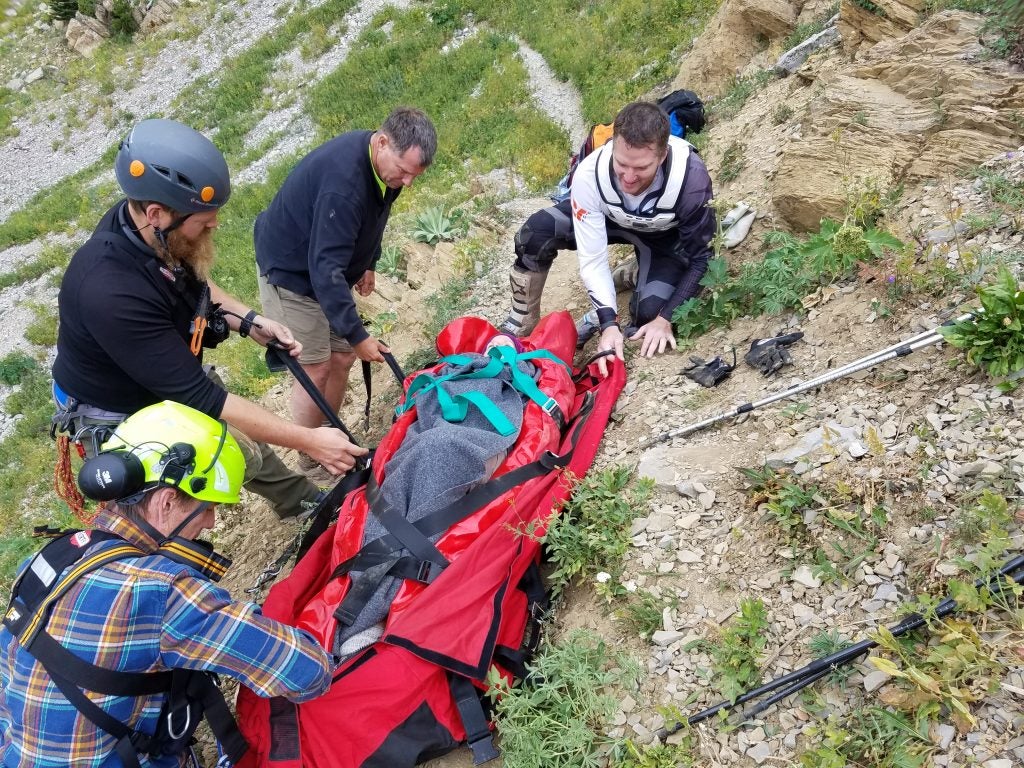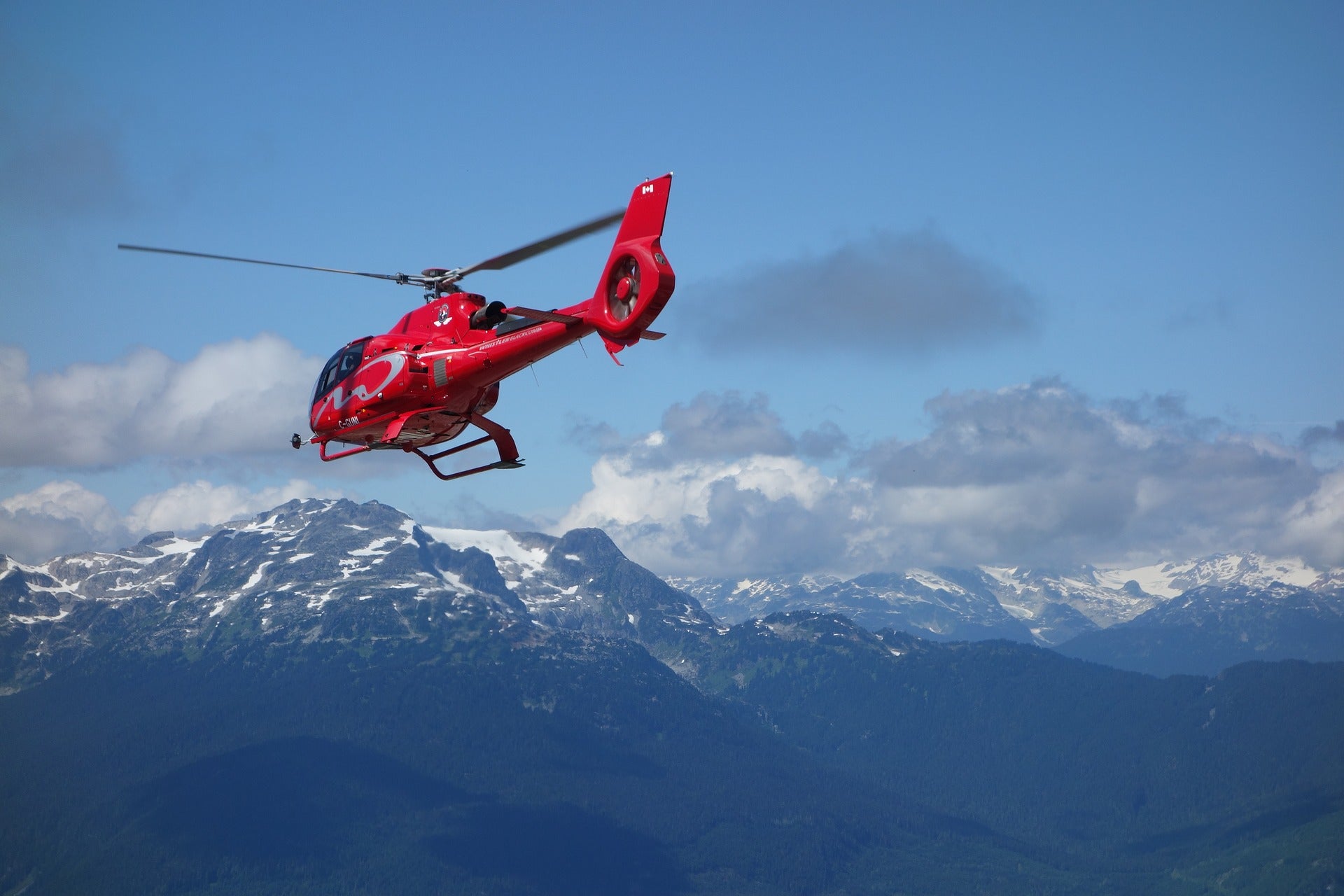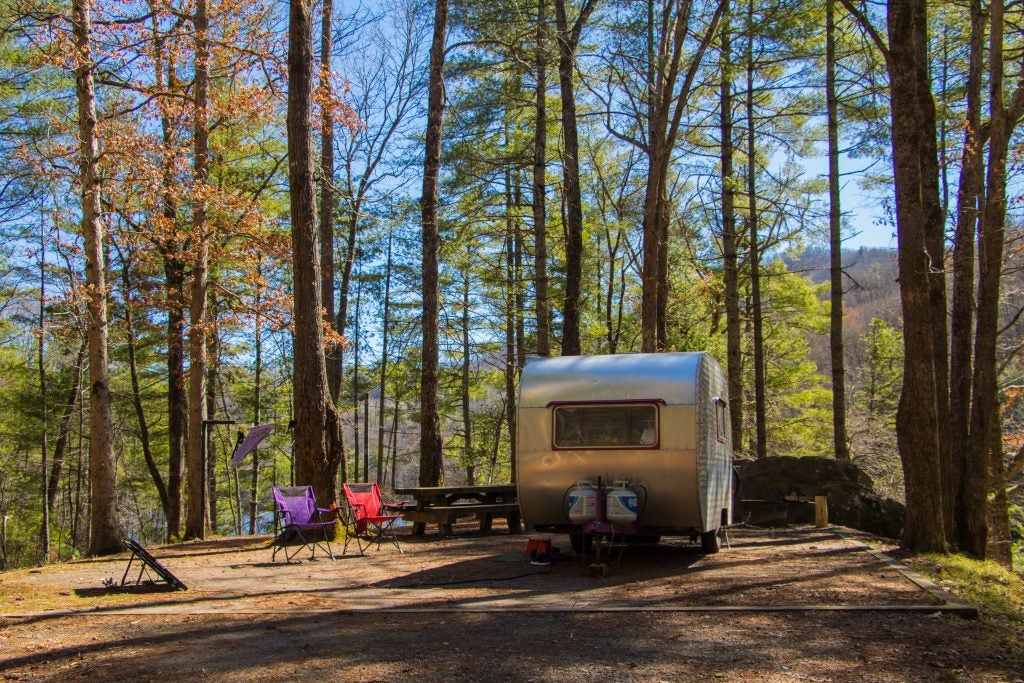This article is brought to you by our friends at Midland Radio — experts in backcountry communication.
Last summer I was hiking in the Bridger Mountains with my parents. We were prepared for this backcountry trek — or so we thought.
The trek went south fast. We spotted some mountain goats as we hiked through a narrow bowl. As they climbed up the talus slope, they dislodged several bowling-ball sized boulders.
One of the jagged cannonballs struck my mom’s leg, inflicting massive damage – hence our backcountry emergency. Our location and the severity of the bleeding wound quickly made this a life or death crisis. As my dad tended to my mom’s injury, I called 911.
By divine intervention, I had cell service in exactly one spot on the trail, and I was able to contact Search and Rescue. Four hours later, the rescue team arrived and airlifted my mom off the ridge.

Prepped to be airlifted off the Bridger Ridge.
Before the trip, I had made upgrades to my backcountry emergency gear and felt confidently prepared. But while my dad and I hiked off the mountain with SAR, there was only one piece of equipment I wish I had in my bag — a personal locator beacon (PLB) or satellite messenger.
I would have been able to call for help regardless of cell coverage.
These devices use a network of satellites that notify national search authorities and the closest first responders of your GPS location within 3-5 minutes.
Give your family peace of mind with a personal locator beacon or satellite messenger
PLBs and satellite messengers aren’t cheap, and I had the misconception that they were only for hardcore backcountry skiers and mountaineers. It seemed like gear that was out of my league. But the truth is, if you go into the backcountry at all, then it is worth adding a PLB or satellite messenger to your pack.
PLBs vs. Satellite Messengers
There are a variety of devices you can use. First, there are personal locator beacons, or PLBs. The sole purpose of PLBs is to send an SOS message to the national search authorities. They do not offer any messaging capabilities, and are strictly used to send your location. These devices tend to be more cost-effective than satellite messengers and do not require a subscription.
Satellite messengers are not only a GPS locator beacon, but also have varying degrees of messaging abilities. They cost more than a PLB and typically require a monthly or annual subscription. If you are out of cell range for extended periods of time or would prefer to have messaging capabilities, then this is an option worth considering.
PLBs and satellite messengers both need to be registered with the National Oceanic and Atmospheric Administration (NOAA) before use.
These devices only call for help, and you are responsible for the financial cost of the rescue — so “SOS” responsibly.
Consider adding one of these to your pack.
ACR Electronics ResQLink+ GPS Personal Locator Beacon
The ResQLink+ GPS Personal Locator Beacon is one of the most popular PLBs on the market. Mainly designed for the marine environment, they are waterproof and buoyant, but would still come in handy for another backcountry emergency. These rugged pocket-sized devices can work anywhere.
Using 2 different global satellite systems, this PLB can guide rescue teams to your location within 100 meters or less. To use, simply lift the antenna and press the ON button. ResQLink is ideal for the backcountry adventurer that wants the extra security without the extra frills.
One of the best perks of the ResQLink is if you use it, then they will replace it free of charge!
SPOT Gen3 Satellite GPS Messenger
The SPOT Gen3 Locator is a PLB with additional messaging capabilities. This device comes with 4 message options.
- SOS: Alert the national search authorities and closest first responders through the GEOS International Emergency Response Coordination Center
- Check-in: Send a pre-programmed message and your GPS coordinates to your 10 pre-programmed contacts letting them know that you are okay
- Help: Use for non-life threatening situations by sending an alert with your GPS location to your 10 personal contacts letting them know you need help
- Custom Message: Set up the custom message beforehand for staying in touch, for example, “okay, but delayed”
When you activate your SPOT locator, you can add up to 10 contacts either phone numbers or email addresses. These contacts will be notified of your location and the corresponding message depending on which of the 4 message buttons you use. This device also allows for continuous tracking and you can log waypoints. The SPOT locator does require a subscription to use.
This is a great option for people who adventure solo and want to keep their family worry-free. Or for those who would like more messaging capabilities while out of cell coverage.
Garmin inReach Devices
The Garmin inReach has all the bells and whistles. With this device, you can send for emergency help, message freely, share your trip progress, and even get weather forecasts. Maximize your trip planning by using in tandem with their mobile app Earthmate®. The inReach comes in 2 different models. There is the inReach Explorer®+ which comes with preloaded topo maps and built-in sensors for the digital compass, barometric altimeter, and accelerometer, and the inReach SE®+ which has the same features except for the topo maps and sensors.
Although it has the highest price tag, this is the only device that offers interactive 2-way communication with the GEOS emergency monitoring center. From my personal experience with Search and Rescue, being able to communicate back and forth with the emergency rescue team is huge for your peace of mind during a crisis.
Even with a GPS-enabled locator beacon, your location is not pinpointed. These devices typically give a location within several hundred feet or more depending on your ability to get a clear view of the sky. To hedge your bets for SAR locating you quickly, consider carrying a whistle or signaling device to help SAR teams zero in on your precise location. Midland’s GXT1000 is a high-powered GMRS two way radio featuring NOAA weather alerts and includes an SOS siren for sending out distress and locator signals. Carrying a PLB and a walkie talkie with an SOS siren, allows you to stay connected even when you’re heading into the backcountry to unplug.
After experiencing a life or death backcountry emergency and relying on my cell phone to call for help, my perception of these locator devices and their importance has certainly changed.
You don’t have to be in the backcountry to lose cell service. You don’t have to be an extreme adventurer to have an emergency. If you play in the great outdoors, then bringing one of these devices with you is worth considering. PLBs and satellite messengers are a simple and effective way to give yourself and family peace of mind — and they could even save your life.
The Dyrt is the fastest-growing camping app on web and mobile, with new features being rolled out regularly. If you love the outdoors, discovering ideal spots to pitch your tent, and being part of a rich and active community, then join us.
The Dyrt is the only camping app with all of the public and private campgrounds, RV parks, and free camping locations in the United States. Download now for iOS and Android.Popular Articles:
Articles on The Dyrt Magazine may contain links to affiliate websites. The Dyrt receives an affiliate commission for any purchases made by using such links at no additional cost to you the consumer.



